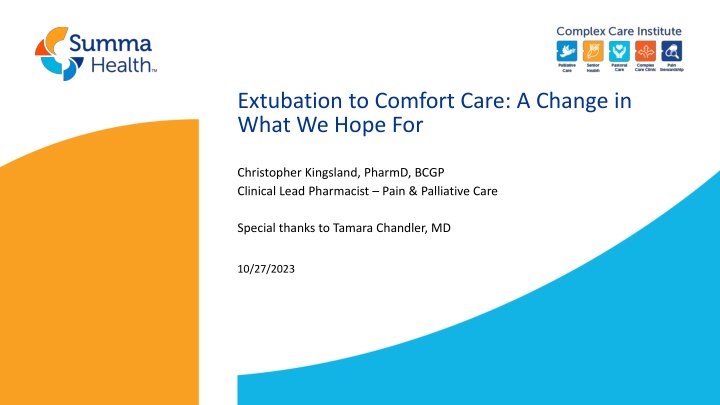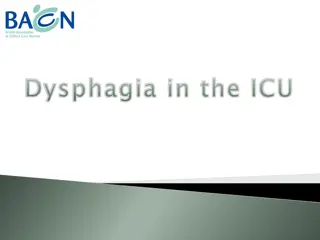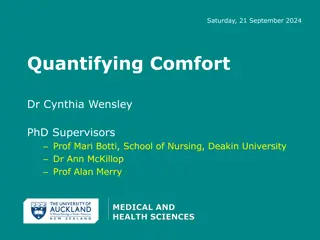
Extubation to Comfort Care in Palliative Medicine
Explore the concept of extubation to comfort care in palliative medicine, including learning objectives, patient cases, and medication management strategies. Understand the intricacies of discontinuing ventilatory support while managing symptoms in a morally equivalent manner.
Download Presentation

Please find below an Image/Link to download the presentation.
The content on the website is provided AS IS for your information and personal use only. It may not be sold, licensed, or shared on other websites without obtaining consent from the author. If you encounter any issues during the download, it is possible that the publisher has removed the file from their server.
You are allowed to download the files provided on this website for personal or commercial use, subject to the condition that they are used lawfully. All files are the property of their respective owners.
The content on the website is provided AS IS for your information and personal use only. It may not be sold, licensed, or shared on other websites without obtaining consent from the author.
E N D
Presentation Transcript
Extubation to Comfort Care: A Change in What We Hope For Christopher Kingsland, PharmD, BCGP Clinical Lead Pharmacist Pain & Palliative Care Special thanks to Tamara Chandler, MD 10/27/2023
Learning objectives 1. Define extubation to comfort care 2. Identify patients for whom extubation to comfort care may be beneficial 3. Explore appropriate symptom management strategies via patient case 4. Discuss medications which may be used to mitigate risk of dyspneic distress and manage post-extubation symptoms 2
Whats in a name? Terminal Extubation vs Terminal Wean Palliative Extubation Compassionate Extubation Extubation to Comfort care Extubation to CCO Extubation with no plans to re-intubate Liberation from the ventilator Withdrawal of ventilatory support Withdrawal of life sustaining treatment (WLST) Transition to comfort care/ go hospice Withdraw/discontinue care Make them comfortable Withdraw support Pull the plug 3
What is it really? Discontinuing ventilatory support with plans to manage the patient s symptoms as they die naturally A complex procedure requiring: A systematic approach Clear communication Smooth Execution Morally equivalent to withholding/not offering ventilatory support (not PAID/MAID/euthanasia) Poorly guided by literature 4
Patient case 1 21 YOF, PMH of muscular dystrophy with spastic quadriplegia and seizures. ICU course complicated by persistent respiratory failure secondary to pseudomonal pneumonia. Intubated via endotracheal route (agitated), parents do not want to seek tracheostomy given likelihood their daughter will never breath on her own again. After multiple family meetings, the decision was made to extubate the patient and pursue comfort-focused care. Home Medications: Baclofen 10mg TID Tizanidine 10mg Clonazepam 4mg AM, 2mg PM, 4mg QHS Phenobarbital 100mg Q12H Levetiracetam 750mg Q12H Has required 5mg IV hydromorphone and 25mg IV midazolam in last 5 hours 5
Patient case 1 continued Patient s parents appropriately tearful, insistent on remaining at bedside for extubation and have low tolerance for seeing their daughter in distress Clonazepam 4mg = lorazepam 8mg = midazolam 16mg Plan: Extubation after premedication Step 1: Initiate hydromorphone 1mg/hr gtt + midazolam 5mg/hr gtt based on last 5 hours. Plan for 100mcg fentanyl + 5mg midazolam 10 minutes prior to extubation and 100mcg fentanyl Q5min PRN pain/dyspnea with RR >22/min + midazolam 5-10mg Q5min PRN anxiety/agitation Step 2: Extubate, and give PRNs Step 3: Re-administer, re-assess, re-position, remove soft restraints Step 4: Increase hydromorphone gtt to 2mg/hr and midazolam to 10mg/hr based on repeated doses within 30 minute interval Step 5: Transfer patient to 3E APCU 6
Why is it necessary? Technological advances in life support within ICU setting have shifted the demographic of those who die within the ICU Patients with chronic, irreversible conditions Question of futile care causing unnecessary suffering/prolonging dying process Patient is dying in spite of aggressive measures 70% of patients with metastatic cancer are Full Code upon admission to hospital Severe TBI, critical polytrauma, restrictive lung disease, ARDS Quality of life may be unacceptable, poor prognosis All attempts to wean the vent have failed 7
What are the stakes? If not correctly executed, increased risk of: Direct patient harm in the form of suffering in the time leading up to death Iatrogenic respiratory depression Catastrophic airway occlusion/stridor Complicated bereavement experienced by loved ones 8
How to prepare Multidisciplinary team meeting (consistency is key) Medical/Surgical/Cardiac ICU Palliative Care Spiritual care Subspecialties as applicable Family meeting Honest/compassionate communication - whoever the patient/decision-maker(s) trusts Topics to address: Surroundings/environment/family involvement Symptom management strategies (pre-medication, post-extubation plan) Prognostication, Code Status (DNR-CC) Likelihood of transfer to a palliative care/hospice unit 9
Helpful communication tips When asked about prognostication: Give a time-range (ex. minutes-hours, hours-days, days-weeks) Let their body be our guide When patient/surrogate decision-maker is (understandably) struggling: Reinforce irreversibility of the patient s condition The worry that by continuing the current direction we d be doing something to someone vs. for someone Patient s goals/values tied to likely prognosis Their body is making this decision We aren t giving up hope, but we can change what we re hoping for Address concerns surrounding euthanasia, nutrition/hydration, spirituality ahead of time Avoid terms such as withdraw care discontinue care 10
A systematic approach 1. Is the patient breathing over the ventilator? If no, why? (underlying pathology vs. opioids, sedatives, paralytics) DC paralytics at least 2 hours before extubation (Train of Four) 2. Is the patient symptomatic/agitated on the ventilator? Rule out 4Ps of Agitation - Pee, Poop, Pain, Pills (withdrawal) Subtherapeutic opioids/sedatives vs discomfort from ET tube 3. Are there opioids/sedatives currently running? Fentanyl gtt > 72hrs is likely at steady state depending on BMI 4. Is the patient opioid/sedative na ve? Check PDMP Factor in fentanyl gtt, scheduled opioids, h(x) OUD/AUD 11
A systematic approach continued 5. Are vasopressors running? How high and how many? Death may occur upon down-titration/discontinuation without need to extubate 6. What is the patient s fluid status? If hypervolemic: IV furosemide at least 40mg x1 prior to extubation 7. Is the patient febrile? Tachypnea will be difficult to control APAP 1g or IV ketorolac 15mg x 1 prior to extubation 8. Is the patient at risk for airway edema? (traumatic/prolonged intubation, self- extubation, obstructive malignancy) If yes (failed cuff leak test /high suspicion) IV dexamethasone (8-10mg) x 1 prior to extubation 9. What should our approach be? Extubation vs. wean 12
Additional clinical considerations Continue vasopressors during pre-medication to ensure adequate systemic circulation Deactivate ICD Discontinue HD/CRRT Discontinue artificial nutrition/hydration 13
Surroundings Ask who would like to be present Determine degree of lighting, additional seating for family/loved ones Remove soft-restraints Switch telemetry monitor to comfort mode or turn it off unless otherwise requested Family may be present for pre-medication, but are often asked to briefly step out of the room for ET tube removal as it may be uncomfortable to watch 14
Always pre-medicate Starting doses of opioids/benzodiazepines should be administered 10-15 minutes before withdrawing respiratory support Opioid/Benzo Naive Hydromorphone 0.5mg IV once 10-20 minutes prior to extubation And Midazolam 1mg IV once 10-20 minutes prior to extubation If not na ve, do the math! 15
Select appropriate PRNs Opioid Na ve Hydromorphone 0.25 Q15min PRN for moderate pain (4-6), or dyspnea as evidenced by RR > 22 and accessory muscle use Or Hydromorphone 0.5mg Q15min PRN for severe pain (7-10), or dyspnea as evidenced by RR > 30 and accessory muscle use ----- Morphine 2mg Q15min PRN for moderate pain (4-6), or dyspnea as evidenced by RR > 22 and accessory muscle use Or Morphine 4mg Q15min PRN for severe pain (7-10), or dyspnea as evidenced by RR > 30 and accessory muscle use Benzodiazepine Na ve Midazolam 0.5mg Q15min PRN for anxiety/agitation ----- Lorazepam 0.25mg Q15min PRN for anxiety/agitation 16
Medication admin, dose stacking, applied PK (oh my) This is how we decrease uncertainty in tricky situations (critically ill patients with pronounced distress and varying degrees of naivety to opioids and gaba-ergic agents) Dose-Dose-Double IV route is preferred Opioids and benzodiazepines often co-administered at an interval consistent with time- to-peak IV Fentanyl: Onset almost immediate , Tpeak 2-5min, duration 30-60min IV Hydromorphone: Onset 5min, Tpeak 10-20min, duration 3-4H IV Morphine: Onset 5-10min, Tpeak 20min, duration 3-5H IV Midazolam: Onset 1min, Tpeak 5 minutes, duration 1-3H IV Lorazepam: Onset 15-20min, Tpeak 2-3H, duration 6-8H 18
Route-specific comparative PK Wickham RJ, et al. J Adv Pract Oncol 2017:8(6);588-607. 19
But how do we do the math? Step 1: Assess patient Step 2: Determine total daily dose (TDD) of currently ordered opioid(s) Fentanyl 150mcg/hr x 96 hrs = 300mg oral morphine/day Oxycodone 5mg per G tube x 4 = 30mg oral morphine/day Morphine 4mg IV x 3 = 36mg oral morphine/day TDD = 366mg oral morphine equivalent (OME) / 24H = 15.25mg oral morphine/hour Step 3: Decide on an opioid agent to administer to manage pain/dyspnea Step 4: Individualize the dose based on patient assessment (step 1), ensuring adequate breakthrough doses Roughly equivalent to 0.75mg IV hydromorphone/hr Would be reasonable to start at 0.5-1mg Q15min as PRN order Step 5: Administer, and follow-up McPherson L, Demystifying Opioid Calculations 2nd Ed. 20
A note on opioids & benzos in peri-extubation period Retrospective Chart Review (N=75) University affiliated level 1 trauma center Patients in ICU requiring removal of mechanical ventilatory support Mean age =59 years ICU admission: ICH 37%, trauma (27%), acute resp. failure (27%) Survival: mean 35min (1-890min) 16 OME/hr avg, 7.5mg/hr (lorazepam mg) starting 1H prior to extubation until the time of death Takeaways: No relationship between opioid dose and time-to-death For every 1mg lorazepam equivalent administered, patients survived 13min longer Chan J, et al. CHEST 2004:126(1);286-93 21
Opioids for dyspnea Both respiratory drive, and chemo-receptor sensitivity to hypercapnia are blunted with opioid dosing Koo C, et al. Open Anesth J 2010;5(1):23-34. 22
Determining benzo doses in GABA tolerant patient Benzo & Phenobarbital - IV:PO = 1:1 Midazolam 2mg Lorazepam 1mg Clonazepam 0.25-0.5mg Phenobarbital 30mg Alprazolam 0.5mg 23
Determining benzo doses in GABA tolerant patient continued Step 1: Assess patient Lost PO route, anticipating extubation to comfort care Step 2: Determine total daily dose (TDD) of currently ordered benzodiazepine(s) Clonazepam 1mg TID = 6mg lorazepam equivalent Lorazepam 0.5mg Q6H PRN (taking all doses) = 2mg lorazepam equivalent TDD = 8mg lorazepam/day Step 3: Determine relative strength of benzodiazepines/barbiturates if able TDD 8mg lorazepam/24H = 0.33mg lorazepam/hr or 0.66mg midazolam/hr Dose:Dose midazolam 1mg to 4mg Step 4: Select an appropriate infusion rate/intermittent dose based on daily amount balanced with duration of action for each agent Midazolam 2mg Q15min PRN anxiety, agitation + midazolam 0.5mg/hr gtt 24
Why benzodiazepines? Dyspnea/air hunger is distressing Triggers release of sympathomimetic catecholamines Increases respiratory rate (likely sacrificing tidal volume if available) Benzodiazepines act synergistically with opioids Midazolam: pronounced amnestic affect Patient less responsive to painful/uncomfortable stimuli 25
But really why benzodiazepines? Morphine (n=35) vs. midazolam (n=33) vs. morphine + midazolam (n=33) single-blinded, single-center intervention Morphine (Mo) 2.5mg Q4H or 25% over PTA opioids with 5mg midazolam PRN breakthrough Midazolam (Mi) 5mg Q4H with 2.5mg morphine PRN breakthrough Morphine (Mm) 2.5mg (or 25% PTA increase) + midazolam 5mg Q4H with 2.5mg morphine PRN breakthrough Group No Dyspnea Relief 48H Takeaway: Opioid effects on dyspnea are improved if a benzodiazepine is co-administered Mo 12.5% Mi 26% Mm 4% Navigante A, et al. J Pain Symptom Manage 2006;31(1):38-46. 26
Monitoring the patient post-extubation Maintain previously agreed upon level of sedation Signs of discomfort (involve family members in monitoring) HR > 120bpm SBP > 160mmHg RR > 30bpm (or doubling baseline) Sustained facial grimace Sustained motor movement/agitation Intercostal retractions or sustained abdominal breathing 27
Ethics in PAD/euthanasia Core Ethical Issue Supporting View Opposing View Are there patients for whom death is beneficial? Some patients may benefit from death The benefit from death is unknown and unknowable to medicine Quantity of life can be sacrificed in interest of quality of life For death to be beneficial, the condition of being dead must be superior to remaining alive Some suffering will only end with the death of the patient The medical profession, nor the patient have empirical knowledge of the condition of being dead Ending life early precludes opportunities for relational and spiritual healing at EOL Goligher EC, et al. Crit Care Med 2017:45(2);149-55. 28
Ethics in PAD/euthanasia Core Ethical Issue Supporting View Opposing View Is physician assisted death/euthanasia morally equivalent to withholding/withdrawing life support/treatment (WWLST)? There is no ethically meaningful difference between PAS/E and WWLST PAS/E and WWLST are ethically distinct because of differences in intent and mechanism of effect The key considerations in PAS/E and WWLST are the same: respecting patient values and sacrificing quantity of life in the interest of quality of life WWLST is not carried out in order to deliberately end the patient s life, although death is often a foreseen consequence The goals of WWLST (comfort, removal of burdensome therapies) are achieved irrespective of whether the patient dies The overall intent in both PAS/E and WWLST is the same: provide comfort The physician who performs WWLST that results in death has the same moral agency as the physician who performs PAS/E Goals of PAS/E are achieved only through the death of the patient Goligher EC, et al. Crit Care Med 2017:45(2);149-55. 29
Ethics in PAD/euthanasia Core Ethical Issue Supporting View Opposing View Is it morally acceptable for physicians to cause death intentionally? Intentionally causing death of patients may sometimes be morally acceptable Intentionally causing death of patients is not morally acceptable Human persons have an intrinsic and incalculable value that transcends circumstance and preference PAS/E is distinguished from murder by the presence of consent and a compassionate motivation Respect for persons necessarily entails we cannot make somebody into nobody There is no reason to allow passive treatment plans that shorten life (WWLST) but not active ones The duty to respect preferences stems from the intrinsic value of the person; honoring preference for death necessarily takes aim at the very basis for respecting the preference If death is certain and the possibility of suffering is significant, PAS/E can be defended on grounds of harm reduction Goligher EC, et al. Crit Care Med 2017:45(2);149-55. 30
Patient case 2 46YOF, PMH of high cervical transverse myelitis secondary to COVID-19 infection 8 months prior, quadriplegia, spasticity, chronic respiratory failure (tracheostomy), multiple pressure injuries. Admitted for sepsis 2/2 MSSA bacteremia. Mother of 2 children. Patient has indicated she no longer wants to live in this state and would like to proceed with removal of life support. 31
Patient case 2 continued Patient was fully alert, saying goodbye to her family who sat vigil at bedside, all grieving appropriately with her favorite music playing in the background Confirmed with RT: no respiratory drive, pulmonology Plan: ventilator wean under deep sedation Step 1. Premedicate via IV route: hydromorphone 1mg, midazolam 2mg; wait 15min Step 2. Decrease tidal volume by 30% and RR from 16 to 12, re-administer hydromorphone 1mg, midazolam 2mg; wait 15min Step 3. Re-administer hydromorphone 1mg, increase to midazolam 4mg; wait 15min Step 4. Decrease tidal volume additional 30%, administer midazolam 2mg; wait 15min Step 5. Transition ventilator to trach mask Total hourly dose: midazolam 10mg, Hydromorphone 3mg Patient died comfortably without taking a breath with family at bedside 32
Extubation vs. vent wean Extubation OK if on minimal vent settings with limited consciousness PEEP < 10, FiO2 < 60% Consider vent wean if moderate-high vent settings with moderate-high consciousness Patient preference for level of awareness Stepwise reduction in ventilator support with concomitant medication administration Gradually reduce FiO2 over 5 min to 30% Gradually reduce to PEEP of 5-8 Have medications at bedside! 33
Some encouragement! There is more than one way to do this well, and also more than one way to do this poorly If you ve seen one extubation to comfort care, you ve seen one Some cases are distressing for even the most seasoned practitioner, and transformative learning takes place in context of disorienting dilemma; let these cases change you Please don t hesitate to reach out to the palliative care team or a trusted colleague for debrief in your own time; things are harder when we feel alone 34
Extubation to Comfort Care: A Change in What We Hope For Christopher Kingsland, PharmD, BCGP Clinical Lead Pharmacist Pain & Palliative Care Special thanks to Tamara Chandler, MD 10/27/2023






















